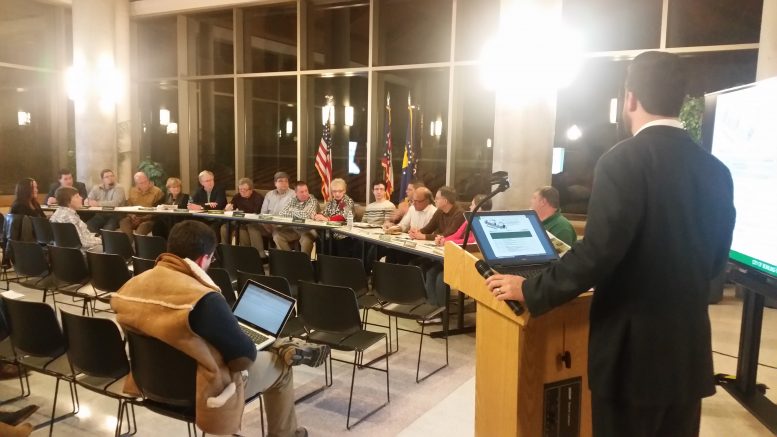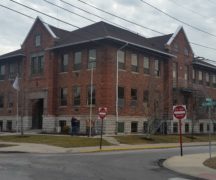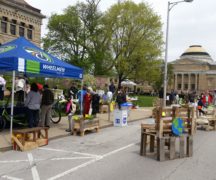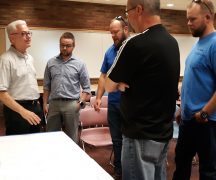By JAN LARSON McLAUGHLIN
BG Independent News
Bowling Green’s leaders got a glimpse of the city’s possible future Wednesday evening. A future of healthy neighborhoods; homes for families, students and everyone in between; a strong business base; access to health and fitness – all adding up to a positive first impression for visitors and prospective residents.
But those changes will take lots of time, lots of work, and lots of money.
“I’m a big believer in the planning process,” City Council member Bruce Jeffers said after the presentation of the finished Community Action Plan.
“When you plant a tree, you don’t plant it for yourself. You plant it for your children and your grandchildren,” Jeffers said.
This plan is similar in that it will take decades to implement. The city, university, private business people and citizens will be asked to help by offering their expertise, investments and elbow grease.
The CAP, which suggests goals for seven areas of the city, was presented to City Council and the Planning Commission by Adam Rosa, of the Camiros consulting firm.
The proposal offered some specific ideas that could benefit the East Side neighborhoods and the community as a whole, such as:
- Diversify the housing stock, invest in new housing and reinvest in the existing stock.
- Set up a rental registration program that would help improve the housing conditions with information about rental available to students and others on a data base.
- Establish a Community Development Corporation to help move along larger projects.
- Offer small mini-grants of about $5,000 or so, to help neighborhood associations spruce up areas.
- Change some zoning codes and reduce parking requirements to stimulate reinvestment.
- Set up a rehabbers network program and a tool lending library. “There’s a lot of power at the neighborhood level,” Rosa said.
- Create attractive, formal entryways to campus.
- Build a hike-bike trail along a creek on the East Side of town.
Rosa did more than paint a picture for the city officials and citizens at Wednesday meeting. He had photographs of communities that faced similar problems as Bowling Green, and were successful at turning those issues around.
For example, South Bend, Indiana, created a beautiful walkable commercial district. Dayton used a Community Development Corporation to transform rundown housing near the university campus. Columbus and Athens, Ohio, have tool lending libraries. Kent built an attractive entryway between its campus and the business district, and used a Community Development Corporation to create loft-type apartments for young professionals and empty nesters.
Paducah, Kentucky, turned an area into a “creative district.” And Athens built a hike-bike trail with 95 percent of it paid for by ODOT.
Amherst, Massachusetts, set up a rental registration data base that has 100 percent of the 1,300 rental properties registered. “The homeowners are very happy with the results. The town looks so much better,” Rosa said.
To get started, Rosa suggested the city set up groups of people to create a Community Development Corporation, a rental registration program, a creative district alliance, and a Friends of the Trail committee.
Council member Sandy Rowland warned Rosa that Bowling Green suffers from “I’m afraid of change” syndrome. Rosa said he finds that syndrome in every community, and suggested that Bowling Green invite people to visit from other communities that have made the changes this city is considering.
“You’re never going to have 100 percent agreement on anything,” Rosa said.
Gary Hess, a member of the city planning commission, asked Rosa how the CAP will help the quality of life on the East Side, where many former single-family homes are now rental properties. “Enhancing residential life on the East Side is important,” Hess said.
Rosa said the plan will promote a balance of fostering new residential development and improvements to established neighborhoods. “We want to be striking the balance between new investment and re-investment,” he said.
The CAP may make developers and investors more confident about putting money into the community, Jeffers said. But he cautioned that it will be a slow process.
“We are not going to be able to fix all our old homes and make them look like they did 50 years ago,” he said.
Jeffers also expressed some reservations about the rental registration program. “We need to tread lightly,” he said, noting the measures the city already has in place to promote safety and home maintenance.
Council member Greg Robinette said the CAP proposals were exciting – and numerous.
“I’m really encouraged by this,” he said, then added that the city would need to prioritize the goals. “We can’t do everything,” Robinette said, suggesting the city look at the CAP like a menu to choose from.
City Council President Mike Aspacher said some of the goals will take decades to accomplish. “Many of these are long-term projects.” He suggested that city officials build on the momentum of the CAP presentation by picking the “low hanging fruit.”
City officials can work on zoning modifications and give developers some tools to entice them, Aspacher said. “Economic development is going to drive everything,” he said.
Council member John Zanfardino said the rental registration program is needed, and that the plan is workable since it is divided into short-, medium- and long-term goals. “Many of them are doable,” he said.
Though the public was not permitted to voice opinions Wednesday evening, Aspacher said citizen comments will be welcome.
“I can assure you there will be opportunities in the future,” he said.
The plan identified Bowling Green’s “assets” as its open space amenities, neighborhood appearance, history and culture, commercial options and educational facilities.
The city’s “issues” were listed as transportation options, renter-homeowner conflict, code enforcement, property maintenance, trash and noise.
The “opportunities” noted were transportation improvements, commercial redevelopment, high-quality multi-family housing development, bicycle and pedestrian improvements, and open space improvements.
The CAP proposes seven priorities:
- Core development area along East Wooster Street, from the edge of BGSU to the downtown. The goal is to create a walkable commercial district. “These major redevelopment projects are a collaboration,” Rosa said.
- Target reinvestment area along North Enterprise and North Summit from Wooster Street to Poe Road; and the area between Manville Avenue and South College Avenue from Wooster to Napoleon Road. These areas are showing signs of deferred maintenance and blight. The goal is to improve these areas by catering to families, post-college professionals and BGSU faculty north of Wooster, and workforce housing to the south.
- Single-family reinvestment adjacent to downtown and the blocks immediately north of Crim Elementary. The goal is to stimulate private renovations, and provide public improvements that can help stimulate reinvestment.
- Transitional development in the blocks of East Wooster between Troup Avenue and Mercer Road, which have been transitioning from single-family to mixed-use. The goal is to transition into a walkable district that blends campus and single-family neighborhoods to the south.
- Multi-family development in the blocks west of Thurstin Avenue, south of Crim Elementary and north of Carter Park. The plan is to promote medium and higher density residential developments, coupled with public investments in pedestrian and bicycle infrastructure.
- Creative district on either side of the CSX tracks between Enterprise and Summit streets on the west, Manville on the east, Clough on the north, and Napoleon Road on the south. The district is intended to incubate creative businesses and entrepreneurships.
- Hike-bike trail along the public right-of-way along a creek that runs from Crim Elementary to Napoleon Road and to Mercer Road.





